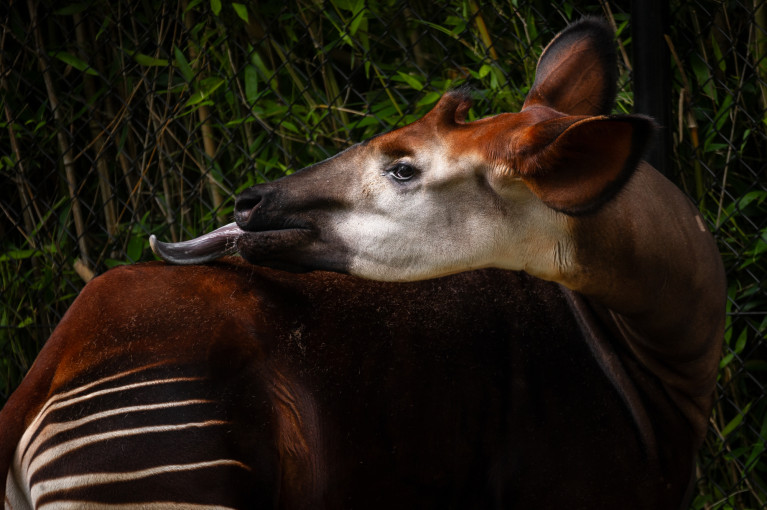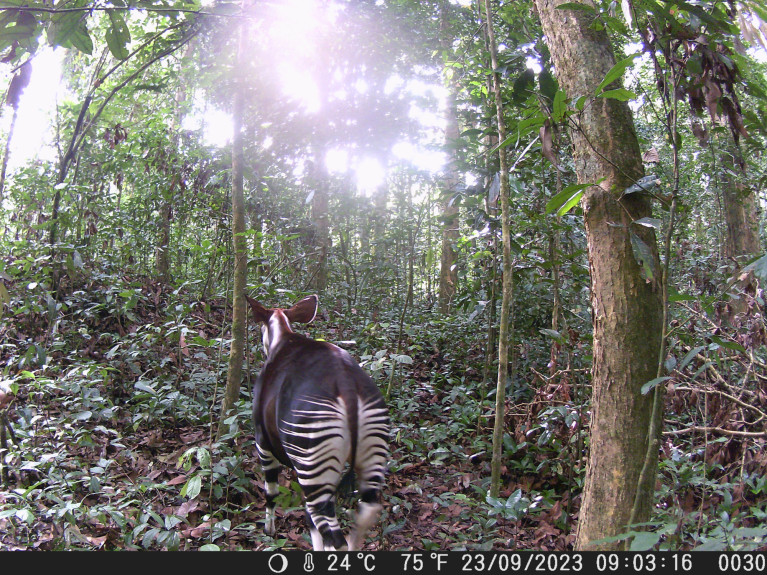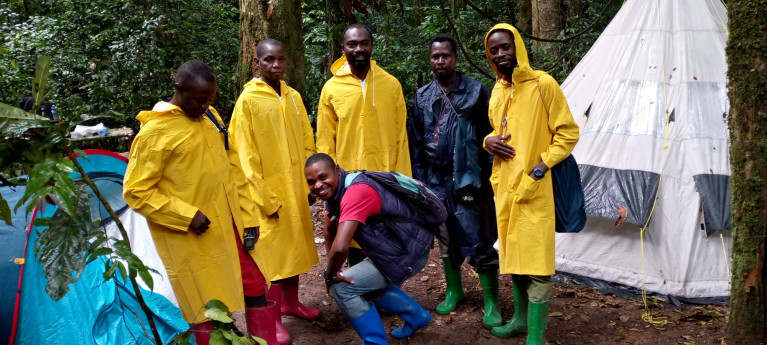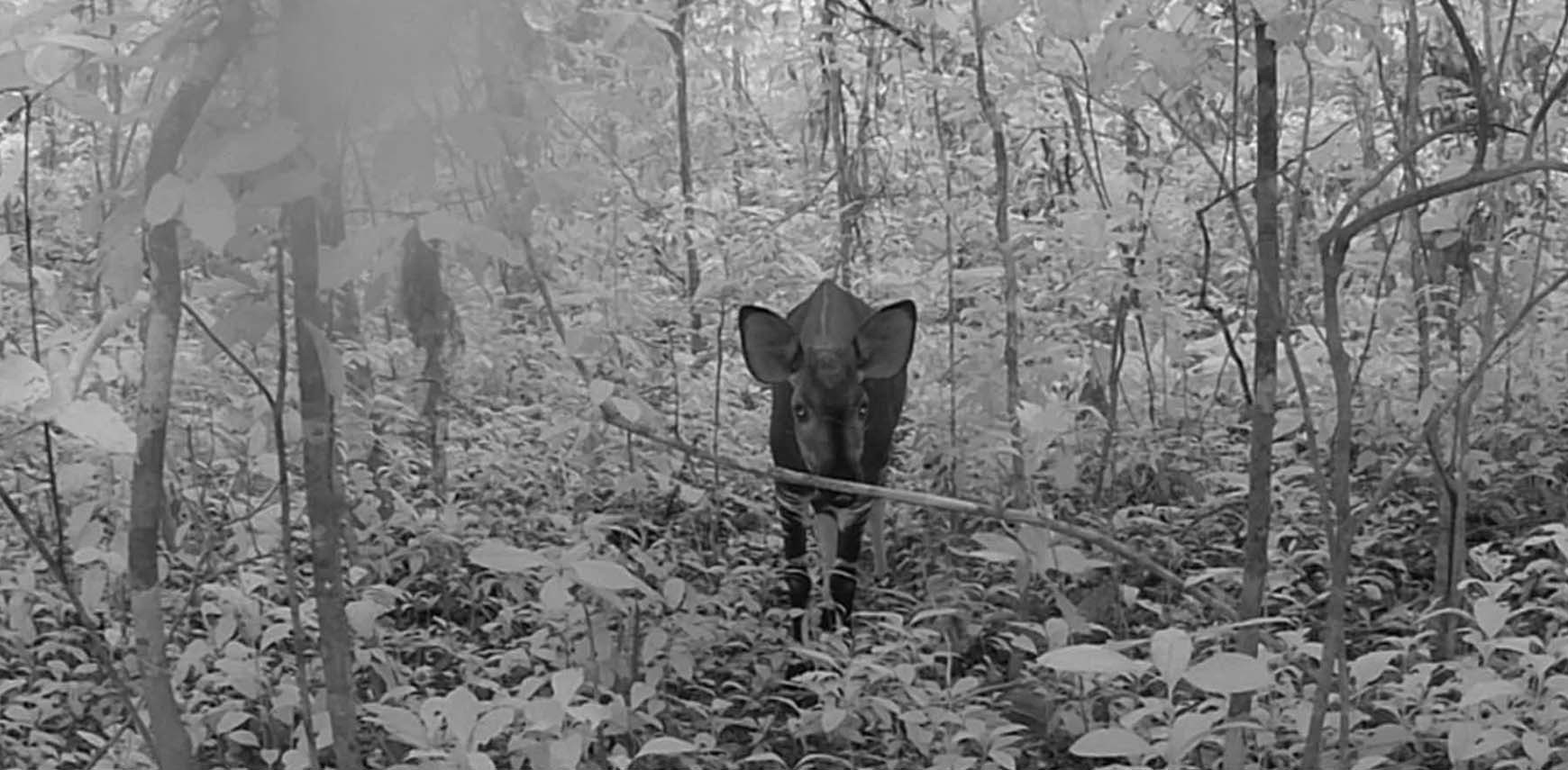World Okapi Day 2025: In Search of New Conservation Prospects in Congo
The okapi – a mysterious inhabitant of Congo’s forests – has been inextricably linked to Antwerp ZOO ever since 1919, when Antwerp ZOO became the first zoo in the Western world to introduce this rare species to the public. Today, more than a hundred years later, this link remains as strong as ever. Together with its conservation branch, the Antwerp Zoo Foundation (AZF), Antwerp ZOO continues to fight for the survival of the okapi. Its efforts are now expanding to a new and little-studied part of the okapi’s natural habitat: the Rubi-Télé region in Congo. A feasibility study is currently being carried out there to explore how okapis in the wild can be better protected. In this way, Antwerp ZOO is further strengthening its leading role in conserving this endangered species in its natural habitat.
‘World Okapi Day on 18 October gives us an extra reason to reflect on how we can keep protecting this unique species – not only in zoos, but also in its natural habitat,’ says Sander Hofman, Animal Care Manager at Antwerp ZOO and coordinator of the EAZA Ex situ Programme (EEP) for the okapi. ‘The okapi is not faring well in eastern Congo. Despite its vast habitat, only about 10,000 animals remain as it stands today.’

A secure future for the okapi
The okapi is found exclusively in the north-east of Congo. Although its habitat covers over 300,000 square kilometres, the wild okapi population is estimated at no more than 10,000 animals, of which around 4,000 live in the Ituri Forest. That means a significant share of the remaining population is concentrated there. The species is under severe pressure from poaching, illegal logging, mining and armed conflict. ‘Their habitat is becoming increasingly fragmented,’ says Sander Hofman, who is also coordinator of the European breeding programme for the okapi. ‘That makes protecting them both difficult and urgent.’
‘The okapi's habitat in east Congo is becoming increasingly fragmented.That makes protecting the remaining 10.000 okapi's both difficult and urgent.’
Antwerp ZOO has supported the Okapi Conservation Project (OCP) in the Ituri Forest, one of the okapi’s key habitats, since the 1990s. Although the area is vast, it is also highly vulnerable: poaching, deforestation for agriculture, illegal mining and armed militias all threaten the survival of this extraordinary species. Even so, local communities work every day to protect the forest and its unique wildlife, often under challenging conditions.
‘Local communities play a crucial role in this,’ says Hofman. In honour of World Okapi Day, numerous activities are organised in and around the reserve to raise awareness of the importance of the okapi and its forest home. Every year, more than 10,000 people take part: education teams travel from village to village with workshops and awareness-raising games, while rangers and conservation workers explain their work. ‘Antwerp ZOO also supports these efforts,’ Hofman adds. ‘We sponsor one of the villages in the forest on that day – a small gesture, but one with great symbolic value. After all, we share this mission with the people who actually live here.’
In search of the okapi in uncharted territory
Although the Ituri Forest is of crucial importance, it is not the only area where okapis live. Determining their range is anything but straightforward, as okapis are extremely shy animals and inhabit dense vegetated forests where they are hard to spot. AZF staff spent many months traversing the forest – and more specifically the Rubi-Télé region, further to the west – looking for tracks and dung samples. Scientists at Antwerp ZOO later analysed the DNA in these samples – with success: the presence of wild okapis in the region was confirmed. Through collaboration with local communities, field observations and GPS tracking, researchers have since mapped several okapi ‘hotspots’ across a densely forested area of some 500 km².

New conservation prospects in the Rubi-Telé region
Together with the challenging working conditions in the Ituri Forest, this discovery prompted a new feasibility study in the more westerly Rubi-Télé region. This area is politically more stable and has hardly been involved in okapi conservation efforts until now.
‘We now know with absolute certainty that okapis live here,’ says Jef Dupain, Director of the Antwerp Zoo Foundation in Congo. ‘Between 2020 and 2022, we collected camera-trap images confirming their presence. The area is vast – about the size of Flanders – yet only five conservationists are working there, and there are hardly any roads.’ The study, an initiative of AZF, was launched at the request of the Institut Congolais pour la Conservation de la Nature (ICCN), which manages all nature reserves in Congo. It explores the feasibility of establishing a full-scale conservation project in the region. ‘The study goes beyond merely confirming the presence of okapis,’ explains Dupain. ‘It will also look into the possibility of involving the local population. Can we develop a project in which the preservation of the forest also benefits the people living in the area?’
A multidisciplinary team of six experts – including biologists, anthropologists, sociologists and legal specialists – is carrying out the research. They are gathering data on biodiversity, land use and the local economy. ‘We want to know exactly where the okapis live, which other species share their habitat, how people use the forest, and the extent to which there is support for joint conservation efforts,’ Dupain says. The ultimate goal? By March 2026, the feasibility study should result in a concrete proposal for a new conservation project, drawn up in consultation with the Congolese government and local communities.

‘The study goes beyond merely confirming the presence of okapis. It will also look into the possibility of involving the local population. Can we develop a project in which the preservation of the forest also benefits the people living in the area?’
Nature’s back-up: the importance of the zoo population
In addition to conservation projects in the okapi’s natural habitat, the zoo population also plays a vital role in safeguarding the species. Antwerp ZOO has been the international herd book keeper for the okapi and coordinates the European Ex situ Programme (EEP) ever since the 1980s. ‘We can trace the lineage of every animal in Europe – where it was born, who its parents are, and whether it is genetically suitable for breeding,’ Hofman explains. ‘In this way, we’re building a healthy reserve population – a kind of back-up for nature itself.’
A total of 28 European zoos take part in the programme, which aims to preserve genetic diversity. That is no unnecessary luxury, as the estimated population of around 10,000 animals in the wild continues to decline. ‘Our goal is not in any way to replace the animals living in their natural habitat,’ Hofman emphasises. ‘It’s far easier and more logical to protect those still living in the wild. But if it ever becomes necessary, the zoo population could help save the species in Congo.’
At the same time, zoos also provide financial support for nature conservation. A third of the funding for the Okapi Conservation Project in Epulu comes from European zoos. ‘The coordinator of the Okapi Conservation Project himself has said that, without the support of the zoos, it is highly likely that this species would already have disappeared from the vast Ituri Forest,’ Hofman adds.
One species, one mission, multiple fronts
Today, Antwerp ZOO plays a unique and pivotal role in okapi conservation. As the keeper of the herd book, an active partner in Congo and the initiator of new projects, the zoo brings together science, fieldwork and education. ‘The okapi has been closely associated with Antwerp ZOO for more than a century,’ Hofman concludes. ‘This extraordinary animal occupies a place at the very heart of our organisation. As the first to introduce the world to the okapi, it is our duty to ensure that this species continues to have a home in the future – especially in its original habitat.’

